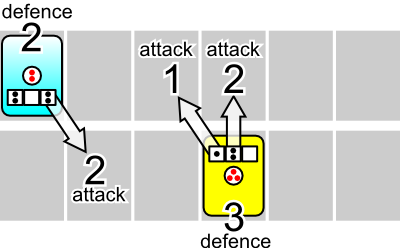Basic Gameplay Design
Last night[1] I finally managed to finish off and order my prototype card designs from a print
on demand service. Even that was quite a bit of work, and there's still a long road to travel.
But I'm getting ahead of myself. This article is a somewhat strained retrospective on how I think I arrived at the overall game design I'm now at.
Please bear in mind that as I'm still prototyping, some of this will be subject to change - to a greater or lesser extent.
Planning the Layout
I started off toying with the concept of multiple interactions between spatially distributed cards.
By this I mean that the position of the cards is important - in general they will interact predominantly with their neigbours.
If we take as an axiom my requirement from last time that the players' cards must not become inter-mixed, many two-dimensional
arrangements are problematic. I decided on an essentially one-dimensional form - facing paired positions. This structure means that no card ever need cross
the central line, and each card has a position relative to all other cards in play.
In initial prototyping I had many cards acting at a distance, but this was largely scaled back, so most cards affect up to three positions on
the opposing side. There are exceptions to this rule, as without them areas become 'safe' very quickly and I feared a single dominant strategy would break the game.
At the moment the 'board' is six positions wide; I briefly trialled a few similar sizes, this seems like a good compromise.
Basic card structure

Diagram of the game board, with example cards showing attacks and defence.
Each card has a defence score. It may also have attack scores which affect the opposing position and its two neigbours,
and/or may have an additional rule which applies to that card.
The basic principle is that a card is destroyed when the attack points against it exceed its defence. As attacks are not cumulative
we don't need to keep track of them, and this also means that defensive cards need to be targeted from several positions to be overwhelmed.
From this we can infer that an attack point is equivalent to a defence point, and can balance such cards by simply assigning a fixed number of points to these pools[2]. After some experimentation, I found six points per card to be a good compromise between variety and managability.
There are a variety of exceptions to the "defence and three attack position" rule. Some cards attack across a five position range. Some cards are reversable. Some heal the adjacent cards, or steal health from their neigbours in exchange for a more powerful attack.
Game Structure
Hands are formed of seven cards. Each player will need two, because a game has two halves - each player has a go at playing first.
Exactly how hands are built needn't concern us right now; they may be by dealt, constructed or some intermediate. However it is important is that all hands
are prepared before the game starts. This has the consequence that any particular card can only be present in one of a player's hands, but the opponent can't use that
knowledge in selecting their second hand.
Onto the six paired-position 'board', players take turns placing a card. Each turn comprises playing a card, performing any special effects, then determining
which cards, if any, are destroyed.
The cards' attacks all occur 'simultaneously'.
This means that a card can contribute to attacking other positions even if it is itself destroyed in the turn it is played.
I'm actually pretty pleased with how this interaction plays out. The calculations are not awfully complex - it helps that a single card is played at a time, so only a
few positions need to be determined at a time.
The winner is the player with the most surviving cards over both halves.
Conclusion
So that covers the basics of the game. Next time I hope to talk about the other half of the deck - the various exceptions and special rules, and also show off some of the card faces I made.
(Published 19th March 2015)
Footnotes
[1] At least, it was when I started writing this article. ↩ return
[2] This is obviously only true in an overall sense, and assumes that attack points are not wasted.
However it is clear that the extreme strategies spending all points on attack or defence can easily be beaten, yet individual cards of
all positions on the spectrum may be tactically useful.
↩ return

Comments